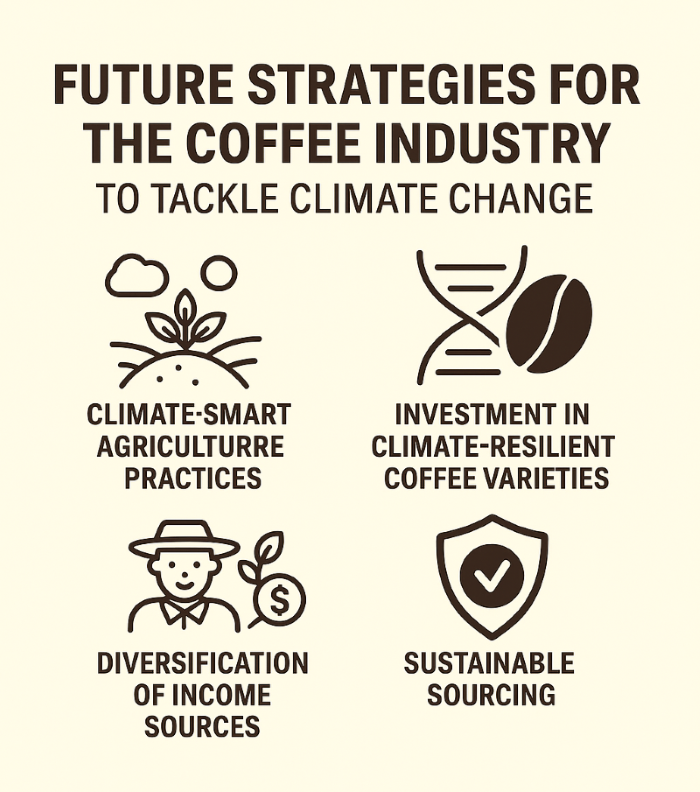Coffee is more than just a daily ritual; it’s a global livelihood, an agricultural staple, and for millions, a way of life. But the very plant that fuels our mornings is under growing threat from climate change. Rising temperatures, shifting rainfall patterns, and an increase in pests and diseases are placing immense pressure on coffee-growing regions around the world.
Despite these challenges, the industry is rising to the occasion. Through innovation, collaboration, and sustainable practices, the future of coffee is being reshaped for the better. Here’s how.
1. Climate-Smart Agriculture Is Leading the Way
One of the most important responses to climate change in coffee production is the adoption of climate-smart agriculture. As temperatures rise and weather becomes more erratic, traditional coffee-growing zones are becoming less viable. Producers are now shifting cultivation to higher altitudes and experimenting with regions once considered unsuitable for coffee.
Agroforestry is also gaining ground, particularly among our producer partners in Kenya. By growing coffee under the natural shade of forest canopies, they not only shield the plants from heat stress and heavy rainfall but also help preserve native ecosystems. This method creates a mutually beneficial balance between agriculture and the environment.
In Brazil, our partners at 3 Porteiras exemplify the benefits of improved irrigation and soil management. Their use of agroecological techniques such as intercropping and soil carbon retention is enhancing soil fertility while conserving water. These practices play a vital role in ensuring long-term productivity and reducing environmental impact.
2. Investing in the Future Through Resilient Coffee Varieties
Another promising strategy is the development of climate-resilient coffee varieties. Traditional Arabica coffee, though beloved for its flavour, is particularly sensitive to climate shifts. In response, breeding programmes are focusing on creating varieties that are more resistant to heat, disease, and pests like coffee leaf rust.
F1 hybrids—first-generation cross-bred plants—are emerging as a reliable solution. These hybrids offer both yield stability and improved resilience, helping to safeguard farmers’ livelihoods against unpredictable weather and disease outbreaks.
3. Supporting Farmers Through Diversification
For many farmers, climate change is not only a threat to coffee crops but also to income stability. Diversifying sources of income is a key adaptation strategy. Our farming communities in Kenya are already practising intercropping—growing coffee alongside other crops like cocoa, spices, or fruits. This not only cushions financial risk but also enhances biodiversity and soil health.
Furthermore, organisations across the supply chain are offering support programmes that help farmers transition to diversified, sustainable farming systems. These initiatives foster greater resilience in farming communities and reduce the risks associated with climate volatility.
4. The Growing Importance of Sustainable Sourcing
Today’s coffee drinkers are increasingly conscious of how their coffee is produced. Sustainability certifications such as Rainforest Alliance include climate-related criteria which are key to gaining certification, ensuring that certified coffee adheres to strict environmental standards.
In recent times more coffee is being sourced directly from the coffee farmers like our Green Ocean ‘Direct from Farm’ model and establishing direct trade relationships. These relationships build stronger connections between growers and buyers, enhance transparency, and create incentives for long-term sustainability investments.
5. Industry Collaboration and Policy Reform
On a global scale, initiatives such as the Sustainable Coffee Challenge and the Coffee & Climate Initiative are bringing together stakeholders from across the coffee world. These collaborations focus on research, training, and implementation of sustainable practices.
However, widespread change also requires political support. Governments in coffee-producing countries play a crucial role in enabling sustainable agriculture by reforming policies, offering incentives, and investing in farmer education. However a balance needs to be arrived at between regulations introduced by consumer counties (such as the EU Deforestation Regulation (EUDR) coming into force in 2026) and producer counties. We have to move in lockstep to create a regulatory environment that works for all stakeholders in order to deliver meaningful change.
Looking Ahead
While the challenges posed by climate change are formidable, the coffee industry is not sitting still. From the farm to the cup, every part of the supply chain is evolving. Through climate-smart farming, innovation in plant science, farmer support, and international collaboration, we can protect the future of coffee—and the communities that depend on it.
Because when coffee grows sustainably, we all benefit.
